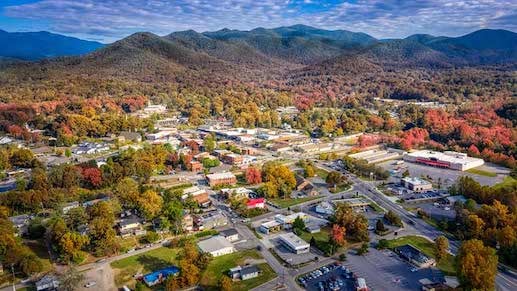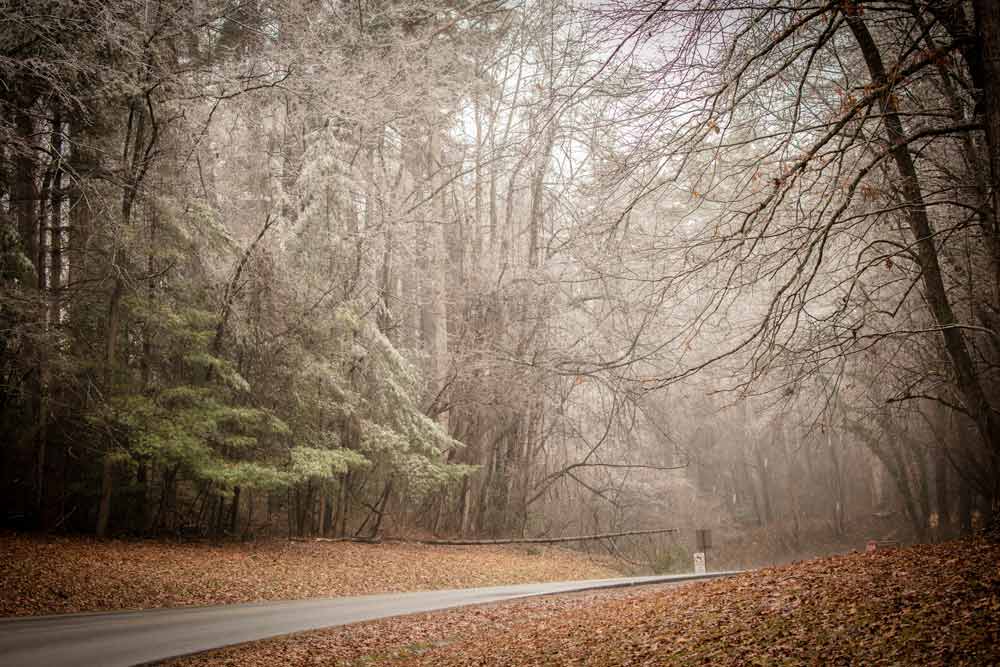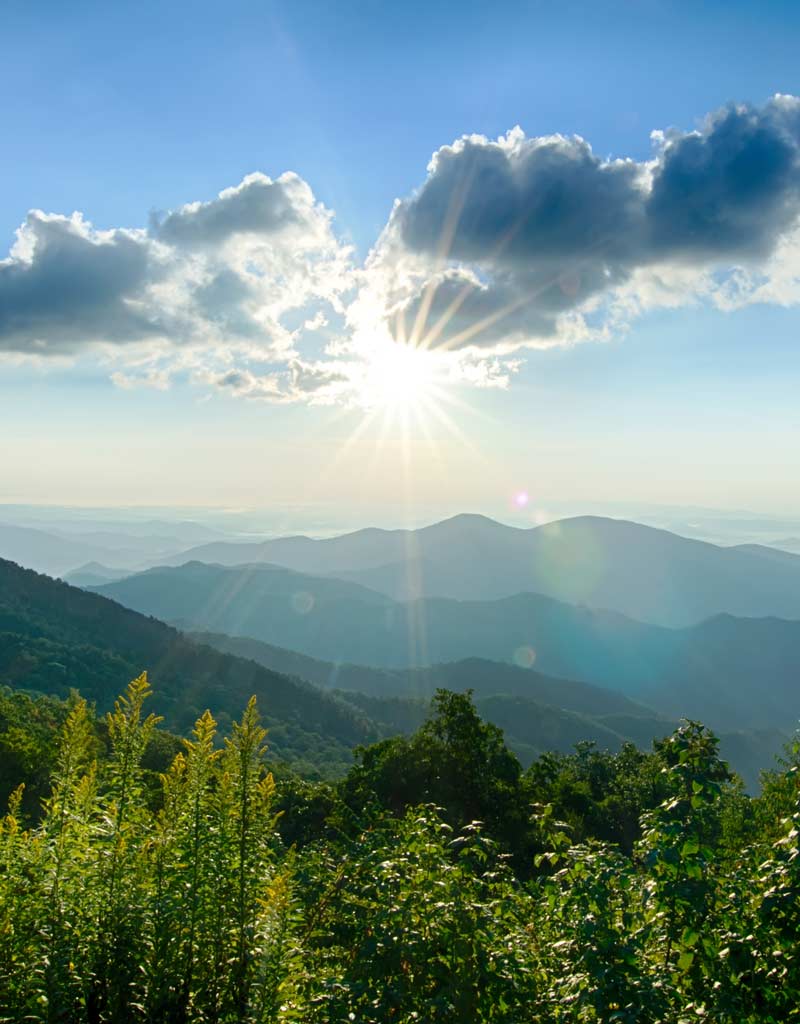Spring in Asheville
Spring in Asheville can bring a wide range of weather, from snow to 90-degree heat. Most Spring days are comfortably warm and modestly humid. Residents and visitors are treated to the appearance of young leaves and wildflowers.
Residents have long sought out the Asheville region for its mild year-round climate, natural beauty, recreational activities, cultural delights, and open spaces. Here, you’ll experience all four seasons beautifully reflected in the Blue Ridge Mountains.
 Summer in downtown Asheville
Summer in downtown Asheville
 Linn Cove Viaduct in Fall
Linn Cove Viaduct in Fall
At over two thousand feet above sea level, Asheville enjoys mild winters with average high temperatures usually landing in or near the 40s and 50s. For decades, Asheville and the Carolina mountain regions have been an escape from the oppressive summer temperatures of the deep south. Crisp Fall and Spring days are complemented by incredible seasonal colors, and sunny Summers make it an ideal place for outdoor activities.
Spring in Asheville can bring a wide range of weather, from snow to 90-degree heat. Most Spring days are comfortably warm and modestly humid. Residents and visitors are treated to the appearance of young leaves and wildflowers.

Summer temperatures in Asheville typically hover in the mid-80s, with occasional highs of 90 or higher. The lowlands, forests, cool streams, and high mountain peaks offer excellent relief from the heat.

Fall brings stunning leaf displays, still-mild temperatures, clear, dry, crisp air, and perfect hiking weather. This is the driest season on average. The brightest fall colors are seen in the valleys from late September to late October or early November on the highest hills.

Asheville sees the occasional snowfall during its wet Winter season, with average highs in the 40s and 50s. Snows generally melt quickly, though they may stay around for a month or more at higher elevations.

Asheville’s warm season typically lasts from May 24th to September 17th, with an average daily high temperature above 76°F.
The hottest month of the year in Asheville is July, with an average high of 82°F and a low of 64°F.
Asheville’s cold season typically lasts from November 30th to February 28th, with an average daily high temperature below 54°F.
The coldest month of the year in Asheville is January, with an average low of 29°F and a high of 47°F.
Asheville is beautifully situated in the Land-of-Sky Region, which spans North Carolina's gorgeous western mountains. The Blue Ridge Mountains on the east and the Great Smoky Mountains on the north and west define this incredible and in-demand part of the country. The geography and landscape vary from colorful valleys to impressive mountains, stretching from Tennessee in the north to the South Carolina border.
The Asheville peneplain, a long flat stretch of land, offers geography that’s noticeably different from that of the surrounding mountains. The plateau, which stands at an elevation of around 2,000 feet, is cut by the meandering French Broad River, which from south to north, and two important tributaries, the Swannanoa to River and Hominy Creek, which dissect the region from east to west.
We’ve gathered just a few of the nearby natural areas that offer incredible views of the Carolina geography.


Take in incredible views from the Great Smokies, Black Mountains, Great Craggy Mountains, Great Balsams, Roan Highlands of the Unakas, and other big Southern Appalachian ranges this special spot atop the 4,600-foot Max Patch Mountain. It’s one is one of the most iconic sites on the entire Appalachian Trail, accessible by a steep but short half-mile hike.
At over 6,200 feet, Black Balsam Knob is the second-highest peak in the Great Balsam Mountains—one of the Appalachian Mountains' most impressive ranges. It's a small hike off the Blue Ridge Parkway near Asheville; a 1.4-mile round-trip out-and-back along the Art Loeb Trail.
Craggy Pinnacle's 5,820-foot summit, one of the taller peaks in the Great Craggies, is located less than 30 miles northeast of Asheville and can be reached through Craggy Gardens along the Blue Ridge Parkway. The trail to the bald crown is just about a mile round-trip, going through a magnificent forest of birch, mountain-ash, buckeye, and other broadleaf trees, as well as thickets of rhododendron and blueberry.
Slicing through the Blue Ridge Mountains, the "Grand Canyon" of Asheville's hinterland is undoubtedly one of the best-known spots for outstanding vistas. Wiseman's View juts out from the sides of Linville Mountain overlooking the vast forested chasm and providing views of several of the Gorge's jagged peaks, most notably Hawksbill Mountain and Table Rock.
The views from the rugged outcrops of Rough Ridge on Grandfather Mountain’s southern flanks are spectacular. The vantages offer a great view of Grandfather Mountain's 5,964-foot apex, Calloway Peak, as well as the Blue Ridge Parkway's famous Linn Cove Viaduct, and are easily reached by climbing to the Tanawha Trail from the Rough Ridge parking area on the Blue Ridge Parkway.
The tallest lookout tower in western North Carolina, the 70-foot viewing point atop 5,340-foot Fryingpan Mountain, which lies along the Pisgah Ridge, is just a short distance from Asheville. This top-notch viewpoint is reached through a short hike (1.5 miles round trip); another spectacular payoff for little time and effort.
Loading Failed
